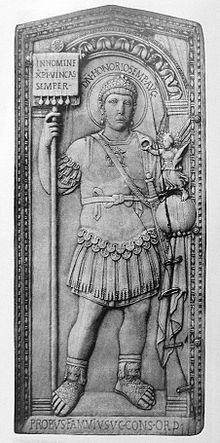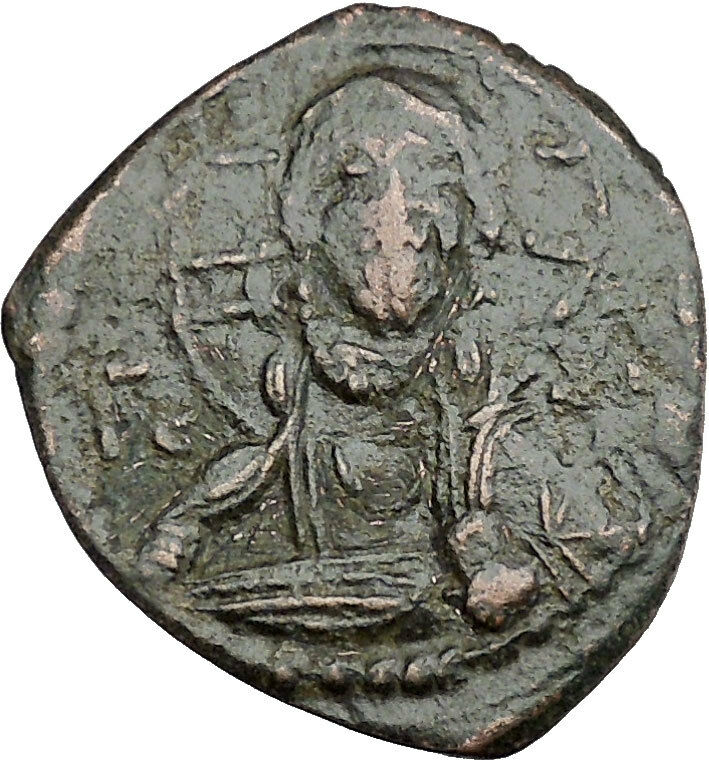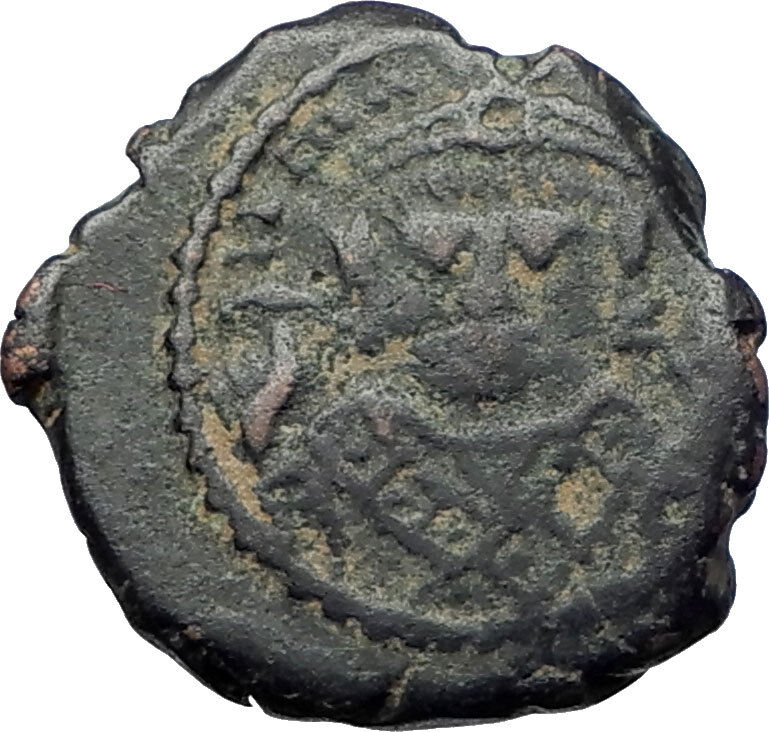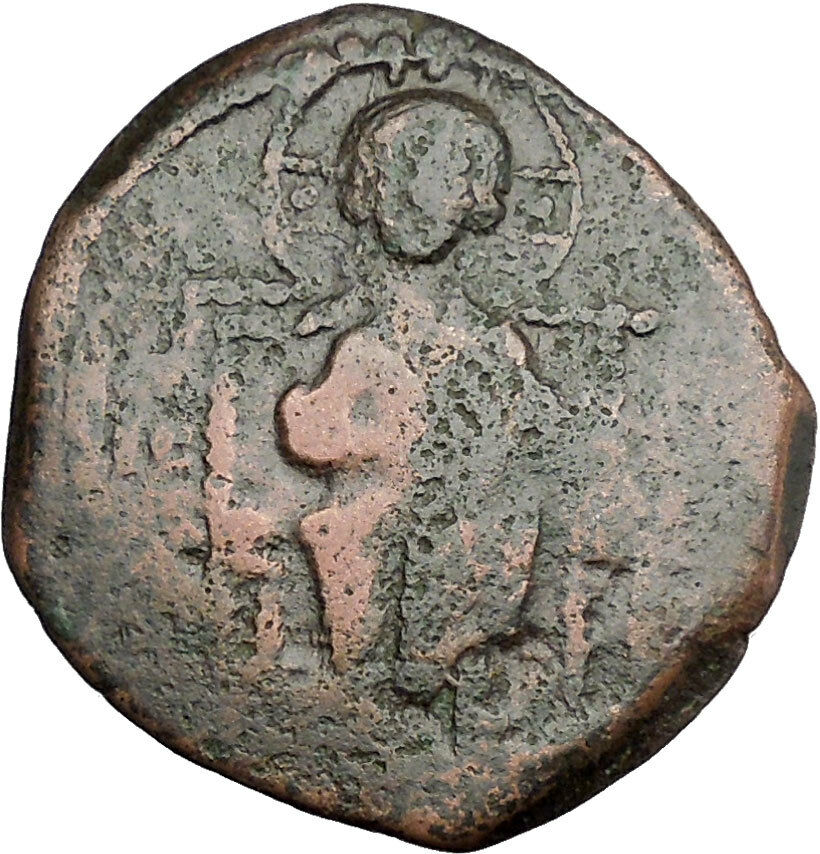|
Byzantine – Latin Rulers of Constantinople 1204-1261 A.D. –
Billon Trachea 24mm (1.85 grams) Constantinople mint: 1204-1261 A.D.
Reference: Sear 2025; DO IV.
Bust of Christ , holding scroll.
Emperor standing, holding labarum-head scepter.
You are bidding on the exact item pictured,
provided with a Certificate of Authenticity and Lifetime Guarantee of
Authenticity.

Labarum of Constantine I, displaying the “Chi-Rho” symbol above.
The labarum was a
vexillum
(military standard) that displayed
the “Chi-Rho”
symbol
☧
, formed from the first two
Greek letters
of the word “Christ”
—
Chi
and
Rho
. It was first used by the
Roman emperor
Constantine I
. Since the vexillum consisted of
a flag suspended from the crossbar of a cross, it was ideally suited to
symbolize the
crucifixion
of
Christ
.
Later usage has sometimes regarded the terms “labarum” and “Chi-Rho” as
synonyms. Ancient sources, however, draw an unambiguous distinction between the
two.
Etymology
Beyond its derivation from Latin labarum, the etymology of the word is
unclear. Some derive it from Latin /labāre/ ‘to totter, to waver’ (in the sense
of the “waving” of a flag in the breeze) or laureum [vexillum] (“laurel
standard”). According to the
Real Academia Española
, the related
lábaro
is also derived from Latin labărum
but offers no further derivation from within Latin, as does the Oxford English
Dictionary.[5]
An origin as a loan into Latin from a Celtic language or
Basque
has also been postulated. There is a
traditional Basque symbol called the
lauburu
; though the name is only attested from
the 19th century onwards the motif occurs in engravings dating as early as the
2nd century AD.
Vision of Constantine

A coin of Constantine (c.337) showing a depiction of his labarum
spearing a serpent.
On the evening of October 27, 312, with his army preparing for the
Battle of the Milvian Bridge
, the emperor
Constantine I
claimed to have had a vision
which led him to believe he was fighting under the protection of the
Christian God
.
Lactantius
states that, in the night before the
battle, Constantine was commanded in a dream to “delineate the heavenly sign on
the shields of his soldiers”. He obeyed and marked the shields with a sign
“denoting Christ”. Lactantius describes that sign as a “staurogram”, or a
Latin cross
with its upper end rounded in a
P-like fashion, rather than the better known
Chi-Rho
sign described by
Eusebius of Caesarea
. Thus, it had both the
form of a cross and the monogram of Christ’s name from the formed letters “X”
and “P”, the first letters of Christ’s name in Greek.
From Eusebius, two accounts of a battle survive. The first, shorter one in
the
Ecclesiastical History
leaves no doubt that
God helped Constantine but doesn’t mention any vision. In his later Life of
Constantine, Eusebius gives a detailed account of a vision and stresses that
he had heard the story from the emperor himself. According to this version,
Constantine with his army was marching somewhere (Eusebius doesn’t specify the
actual location of the event, but it clearly isn’t in the camp at Rome) when he
looked up to the sun and saw a cross of light above it, and with it the Greek
words
Ἐν Τούτῳ Νίκα
. The traditionally employed
Latin translation of the Greek is
in hoc signo vinces
— literally “In this
sign, you will conquer.” However, a direct translation from the original Greek
text of Eusebius into English gives the phrase “By this, conquer!”
At first he was unsure of the meaning of the apparition, but the following
night he had a dream in which Christ explained to him that he should use the
sign against his enemies. Eusebius then continues to describe the labarum, the
military standard used by Constantine in his later wars against
Licinius
, showing the Chi-Rho sign.
Those two accounts can hardly be reconciled with each other, though they have
been merged in popular notion into Constantine seeing the Chi-Rho sign on the
evening before the battle. Both authors agree that the sign was not readily
understandable as denoting Christ, which corresponds with the fact that there is
no certain evidence of the use of the letters chi and rho as a Christian sign
before Constantine. Its first appearance is on a Constantinian silver coin from
c. 317, which proves that Constantine did use the sign at that time, though not
very prominently. He made extensive use of the Chi-Rho and the labarum only
later in the conflict with Licinius.
The vision has been interpreted in a solar context (e.g. as a
solar halo
phenomenon), which would have been
reshaped to fit with the Christian beliefs of the later Constantine.
An alternate explanation of the intersecting celestial symbol has been
advanced by George Latura, which claims that Plato’s visible god in Timaeus
is in fact the intersection of the Milky Way and the Zodiacal Light, a rare
apparition important to pagan beliefs that Christian bishops reinvented as a
Christian symbol.
Eusebius’ description of the labarum
“A Description of the Standard of the Cross, which the Romans now call the
Labarum.” “Now it was made in the following manner. A long spear, overlaid with
gold, formed the figure of the cross by means of a transverse bar laid over it.
On the top of the whole was fixed a wreath of gold and precious stones; and
within this, the symbol of the Saviour’s name, two letters indicating the name
of Christ by means of its initial characters, the letter P being intersected by
X in its centre: and these letters the emperor was in the habit of wearing on
his helmet at a later period. From the cross-bar of the spear was suspended a
cloth, a royal piece, covered with a profuse embroidery of most brilliant
precious stones; and which, being also richly interlaced with gold, presented an
indescribable degree of beauty to the beholder. This banner was of a square
form, and the upright staff, whose lower section was of great length, of the
pious emperor and his children on its upper part, beneath the trophy of the
cross, and immediately above the embroidered banner.”
“The emperor constantly made use of this sign of salvation as a safeguard
against every adverse and hostile power, and commanded that others similar to it
should be carried at the head of all his armies.”
Iconographic career under Constantine

Coin of
Vetranio
, a soldier is holding two
labara. Interestingly they differ from the labarum of Constantine in
having the Chi-Rho depicted on the cloth rather than above it, and
in having their staves decorated with
phalerae
as were earlier Roman
military unit standards.

The emperor
Honorius
holding a variant of the
labarum – the Latin phrase on the cloth means “In the name of Christ
[rendered by the Greek letters XPI] be ever victorious.”
Among a number of standards depicted on the
Arch of Constantine
, which was erected, largely
with fragments from older monuments, just three years after the battle, the
labarum does not appear. A grand opportunity for just the kind of political
propaganda that the Arch otherwise was expressly built to present was missed.
That is if Eusebius’ oath-confirmed account of Constantine’s sudden,
vision-induced, conversion can be trusted. Many historians have argued that in
the early years after the battle the emperor had not yet decided to give clear
public support to Christianity, whether from a lack of personal faith or because
of fear of religious friction. The arch’s inscription does say that the Emperor
had saved the
res publica
INSTINCTV DIVINITATIS
MENTIS MAGNITVDINE (“by greatness of mind and by instinct [or impulse]
of divinity”). As with his predecessors, sun symbolism – interpreted as
representing
Sol Invictus
(the Unconquered Sun) or
Helios
,
Apollo
or
Mithras
– is inscribed on his coinage, but in
325 and thereafter the coinage ceases to be explicitly pagan, and Sol Invictus
disappears. In his
Historia Ecclesiae
Eusebius further reports
that, after his victorious entry into Rome, Constantine had a statue of himself
erected, “holding the sign of the Savior [the cross] in his right hand.” There
are no other reports to confirm such a monument.
Whether Constantine was the first
Christian
emperor supporting a peaceful
transition to Christianity during his rule, or an undecided pagan believer until
middle age, strongly influenced in his political-religious decisions by his
Christian mother
St. Helena
, is still in dispute among
historians.
As for the labarum itself, there is little evidence for its use before 317.In
the course of Constantine’s second war against Licinius in 324, the latter
developed a superstitious dread of Constantine’s standard. During the attack of
Constantine’s troops at the
Battle of Adrianople
the guard of the labarum
standard were directed to move it to any part of the field where his soldiers
seemed to be faltering. The appearance of this talismanic object appeared to
embolden Constantine’s troops and dismay those of Licinius.At the final battle
of the war, the
Battle of Chrysopolis
, Licinius, though
prominently displaying the images of Rome’s pagan pantheon on his own battle
line, forbade his troops from actively attacking the labarum, or even looking at
it directly.[16]
Constantine felt that both Licinius and
Arius
were agents of Satan, and associated them
with the serpent described in the
Book of Revelation
(12:9).
Constantine represented Licinius as a snake on his coins.
Eusebius stated that in addition to the singular labarum of Constantine,
other similar standards (labara) were issued to the Roman army. This is
confirmed by the two labara depicted being held by a soldier on a coin of
Vetranio
(illustrated) dating from 350.
Later usage

Modern ecclesiastical labara (Southern Germany).

The emperor
Constantine Monomachos
(centre
panel of a Byzantine enamelled crown) holding a miniature labarum
The Latin Empire or Latin Empire of Constantinople (original
Latin
name: Imperium Romaniae, “Empire of
Romania
“)
is the name given by historians to the
feudal
Crusader state
founded by the leaders of the
Fourth Crusade
on lands captured from the
Byzantine Empire
.
It was established after the capture of
Constantinople
in 1204 and lasted until 1261. The Latin Empire was intended
to supplant the Byzantine Empire as titular successor to the
Roman
Empire
in the east, with a Western
Catholic
emperor enthroned in place of the
Orthodox
Byzantine emperors
.
Baldwin IX
,
Count of
Flanders
, was crowned the first Latin emperor as Baldwin I on 16 May 1204.
The Latin Empire failed to attain political or economic dominance over the other
Latin powers that had been established in former Byzantine territories in the
wake of the Fourth Crusade, especially
Venice
, and
after a short initial period of military successes it went into a steady
decline. Weakened by constant warfare with the Bulgarians and the Greek
successor states, it eventually fell to the
Empire of Nicaea
under Emperor
Michael VIII Palaiologos
in 1261. The last Latin emperor,
Baldwin II
, went into exile, but the imperial title survived, with several
claimants to it, until the 14th century.
//
History
Creation
of the Latin Empire
By arrangement among the crusaders, Byzantine territory was divided: in the
Partitio terrarum imperii Romanie, signed on 1 October 1204, three
eighths – including Crete
and other islands – went to the
Republic of
Venice
. The Latin Empire claimed the remainder, and did exert control over
areas of Greece
,
divided into
vassal
fiefs
:
the
Kingdom of Thessalonica
, the
Principality of Achaea
, the
Duchy of Athens
,
the
Duchy of the Archipelago
and the short-lived
duchies of Nicaea
,
Philippopolis, and
Philadelphia
.
The
Doge of Venice
did not rank as a vassal to the Empire, but his position in control of 3/8 of
its territory and of parts of Constantinople itself, ensured Venice’s influence
in the Empire’s affairs. However, much of the former Byzantine territory
remained in the hands of rival
successor states
led by Byzantine Greek aristocrats, such as the
Despotate of
Epirus
, the
Empire of Nicaea
,
and the
Empire of
Trebizond
, which were bent on reconquest from the Latins.
The crowning of Baldwin and the creation of the Latin Empire had the curious
effect of creating three so-called Roman Empires in Europe at the same time, the
others being the
Holy Roman Empire
and the remnants of the
Byzantine Empire
(the direct successor of the ancient Roman Empire), none of which actually
controlled the city of
Rome
, which was under the
temporal authority
of the
Pope.
The
Empire in Asia Minor

Capture of Constantinople during the
Fourth Crusade
in 1204.
The initial campaigns of the crusaders in Asia Minor resulted in the capture
of most of Bithynia
by 1205, with the defeat of the forces of
Theodore I Lascaris
at Poemanenum and Prusa. Latin successes continued, and
in 1207 a truce was signed with Theodore, newly proclaimed Emperor of Nicaea.
The Latins inflicted a further defeat on Nicaean forces at the Ryndakos river in
October 1211, and three years later the
Treaty of Nymphaeum (1214)
recognized their control of most of Bithynia and
Mysia
.
The peace was maintained until 1222, at which point the resurgent power of
Nicaea felt sufficiently strong enough to challenge the Latin Empire, by that
time weakened by constant warfare in its European provinces. At the
battle of Poemanenum
in 1224, the Latin army was defeated, and by the next
year Emperor
Robert of Courtenay
was forced to cede all his Asian possessions to Nicaea,
save Nicomedia
and the territories directly across Constantinople. Nicaea turned
also to the
Aegean, capturing the
islands awarded to the Empire. In 1235, finally, the last Latin possessions fell
to Nicaea.
The
Empire in Europe
Unlike in Asia, where the Latin Empire faced only an initially weak Nicaea,
in Europe it was immediately confronted with a powerful enemy: the
Bulgarian
tsar
Kaloyan
. When Baldwin campaigned against the Byzantine lords of
Thrace
, they
called upon Kaloyan for help. At the
Battle of Adrianople
on 14 April 1205, the Latin heavy cavalry was lured
into an ambush by Kaloyan’s troops, and Emperor Baldwin was captured. He was
imprisoned in the Bulgarian capital
Tarnovo
until his death later in 1205. Luckily for the new Latin Emperor,
Henry of
Flanders
, Kaloyan was murdered a couple of years later (1207) during a siege
of
Thessalonica
, and the Bulgarian threat conclusively defeated with a victory
the following year, which allowed Henry to reclaim most of the lost territories
in Thrace until 1210, when peace was concluded with the marriage of Henry to
Maria of Bulgaria
, tsar
Kaloyan
‘s daughter.
At the same time, another Greek successor state, the
Despotate of
Epirus
, under
Michael I Komnenos Doukas
, posed a threat to the Empire’s vassals in
Thessalonica and Athens. Henry demanded his submission, which Michael provided,
giving off his daughter to Henry’s brother Eustace in the summer of 1209. This
alliance allowed Henry to launch a campaign in
Macedonia
, Thessaly
and
Central Greece
against the rebellious
Lombard
lords of Thessalonica. However, Michael’s attack on the Kingdom of Thessalonica
in 1210 forced him to return north to relieve the city and to force Michael back
into submission.
In 1214 however, Michael died, and was succeeded by
Theodore Komnenos Doukas
, who was determined to capture Thessalonica. On 11
June 1216, while supervising repairs to the walls of Thessalonica, Henry died,
and was succeeded by
Peter
of Courtenay
, who himself was captured and executed by Theodore the
following year. A regency was set up in Constantinople, headed by Peter’s widow,
Yolanda of
Flanders
until 1221, when her son
Robert of
Courtenay
was crowned Emperor. Distracted by the renewed war with Nicaea,
and waiting in vain for assistance from Pope
Honorius III
and the King of France
Philip II
,
the Latin Empire was unable to prevent the final fall of Thessalonica to Epirus
in 1224. Epirote armies then conquered Thrace in 1225-26, appearing before
Constantinople itself. The Latin Empire was saved for the time by the threat
posed to Theodore by the Bulgarian tsar
Ivan II Asen
, and a truce was concluded in 1228.
Decline
and Fall
After Robert of Courtenay died in 1228, a new regency under
John of Brienne
was set up. After the disastrous Epirote defeat by the Bulgarians at the
Battle
of Klokotnitsa
, the Epirote threat to the Latin Empire was removed, only to
be replaced by Nicaea, which started acquiring territories in Greece. Emperor
John III Doukas Vatatzes
of Nicaea concluded an alliance with Bulgaria,
which in 1235 resulted in joint campaign against the Latin Empire, and an
unsuccessful
siege of Constantinople
the same year. In 1237,
Baldwin II
attained majority and took over the reins of a much-diminished
state. The Empire’s precarious situation forced him to travel often to Western
Europe seeking aid, but largely without success. In order to gain money, he was
forced to resort to desperate means, from removing the lead roofs of the
Great Palace
and selling them, to handing over his only son, Philip, to
Venetian merchants as a guarantee for a loan.
By 1247, the Nicaeans had effectively surrounded Constantinople, with only
the city’s strong
walls
holding them at bay, and the
Battle of
Pelagonia
in 1258 signaled the beginning of the end of Latin predominance in
Greece. Thus, on July 25, 1261, with most of the Latin troops away on campaign,
the Nicaean general
Alexios Strategopoulos
found an unguarded entrance to the city, and entered
it with his troops, restoring the Byzantine Empire for his master,
Michael VIII Palaiologos
.
Titular
claimants
For about a century thereafter, the heirs of Baldwin II continued to use the
title of Emperor of Constantinople, and were seen as the overlords of the
various remaining Latin states in the
Aegean
.
They exercised effective authority in Greece only when actually ruling as
princes of Achaea
, as in 1333–1383. Although they are generally regarded as
titular emperors, the continued existence of Latin states in the Aegean that
recognized them as their suzerains makes the term a misnomer; a more accurate
description would be emperors-in-exile.
Organization
and Society
Administration
The empire was formed and administrated on Western European feudal
principles, incorporating some elements of the Byzantine bureaucracy. The
Emperor was assisted by a council, composed of the various barons, the Venetian
podestà
and
his six-member council. This council had a major voice in the governance of the
realm, especially in the periods of regency, where the Regent (moderator
imperii) was dependent on their consent to rule. The podesta, likewise, was
an extremely influential member, being practically independent of the Emperor.
He exercised authority over the Venetian quarters of Constantinople and
Pera
and the
Venetian dominions within the Empire, assisted by a separate set of officials.
His role was more that of an ambassador and
vicegerent
of Venice than a vassal to the Empire.
Society
The elite of the empire were the Frankish and Venetian lords, headed by the
Emperor, the barons and the lower-ranking vassals and liege lords, including
many former Byzantine aristocrats. The bulk of the people were
Orthodox
Greeks
, still divided according to the Byzantine system in income classes
based on land ownership.
Church
As with all Latin states, the Orthodox hierarchy was replaced by
Catholic
prelates
, but not suppressed. An expansive Catholic hierarchy was
established, under the dual supervision of the Latin
archbishop
of Constantinople and the
Papal
legate
, until the two offices were merged in 1231. Catholic monastic orders,
such as the
Cistercians
, the
Dominicans
and the
Franciscans
were established in the Empire. The Orthodox clergy retained its
rites and customs, including its right to marriage, but was demoted to a
subordinate position, subject to the local Latin bishops.
|















